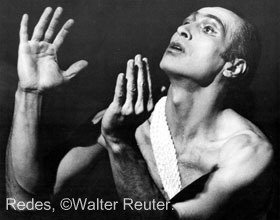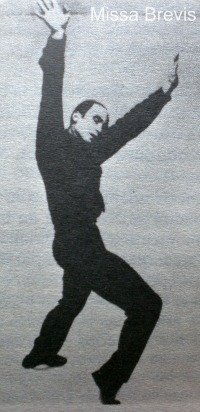JOSE LIMON
“The Moor’s Pavane” may be the most famous piece created by Jose Limon, the Mexican modern dancer and choreographer.
It is a representative example of his narrative, expressive and socially engaged style where a dramatic situation (in this case Shakespeare’s Othello) is expressed through characters, contextualized costumes, modern dance vocabulary, contextualized dance elements (here specifically pre classical or baroque dance) and pantomime.
Around 1940, Limon had conquered a big admiration by the audience in New York, which would create a legendary remembering about him as a performer. People said that he had a magnificently sculpted face and a sensible body; his presence was magnetic and powerful; he’d had a great charismatic personality that made the work with him joyful and pleasant.
Popularly, he was considered one of the best dancers of the time. In critic John Martin’s words, he moved with the precision, force and lightness of a panther.
Short biography

He is born In Culiacán, Sinaloa in 1908. His father, Florencio Limón, is a musician of French-Spanish ascendancy and his mother, Francisca, comes from a Spanish-Indian mixed blood family.
The Mexican revolution, and the following closing of the music academy where his father works, make his family migrate to the United States of America in 1918.
His sensibility takes him always towards the way of arts. First, he decides to be a painter and enters the University of California to study Fine Arts. Later, he continues his studies in New York, where he gets closer to the artistic modern movement of the time.
He disagrees with the ideas about the modern painting, and sticks rather to a more classical style. Being progressively disappointed with visual arts, one day he meets his true vocation (dancing) and redirects his studies.
Invited by a close friend, Jose Limon assists to a performance offered by the German expressionist dancer Harald Kreuzberg. Kreutzberg’s work touches him so deeply that Limon instantly decides to become a dancer.
At the age of 22, he starts studying under the guidance of Doris Humphrey. In 1946, he founds the Limon Dance Company and debuts in 1947. The company does some of the most spectacular tours of the 50s and 60s, dancing through Europe and South America and being successful everywhere.
Jose Limon acquires his bases for dance technique from Doris Humphrey. Her companion Charles Weidman teaches him pantomime and expression. He faithfully develops and complements all dancing principles from Humphrey, to which he adds the characteristics of his own personality, his temperament and his origins.
In that sense Jose Limon is considered (and he considers himself as well) as a continuator of the established codes already elaborated by modern dance. His main contribution is to use them to display his own expressive interests. In later years, Limon will attribute his primary stylistic influences to Isadora Duncan and Harald Kreutzberg as well.
Limon’s choreography is shaped by the choice of acting (in a theatrical sense) the choreographic action, using a narrative dramaturgy with concrete subjects and logical development. Therefore it is common to see frequent use of facial expression and hands in his dances.
His work also searches for a wide expressive spectrum (for both male and female dancers), using physical force and complex movements, together with tenderness and lyricism. But, the technical dancing skills always serve concrete dramas: dances that express a sensible reflection and respect for human happiness and pain.
His assorted choreographic production can be divided in some main inclinations, which have the common element of social concern as feature:
- A religious feeling: “El árbol del Edén” (1952); “La visitación” (1952); “Ahí está el tiempo”, which has a biblical subject; “Missa brevis” (1958).
- The Mexican tradition: “La Malinche” (1949) which is the story of the Mexican woman that betrays her country for Hernán Cortés; “Los cuatro soles”; “Redes”; “Tonantzintla”.
- Theater based dances: “La pavana del moro” (1949) inspired on Shakepeare’s Otello; “Salmo” (1967) based on the inhumanity of the concentration camps; “Leyenda” (1968) which is about the arbitrariness of the slavery system in the U.S.A. of the XIX century.

Limon worked as a teacher to. He is recognized for being the main spreader of Humphrey’s technique in Europe. Though, his dancers were also taught to go over the technical training to find their own emotional and dramatic motivations.
There’s a renowned book entitled “The illustrated dance technique of Jose Limon”, produced by Daniel Lewis (director and founder of the Limon Institute), who was the closest assistant of the choreographer for over seven years.
The book is the first documentary work on the subject. There you can find detailed historical and technical information about the dancing style of Jose Limon. You’ll see it is generously illustrated. It explains a complete class about the technique (in detail) including videos (can be really useful for teachers, dancers and choreographers interested in this style).
Another possible reading is the book “Jose Limon: Un Unfinished Memoir”. Other than Limon’s memories, it includes a compilation of texts by Carla Maxwell (first hand informer, as she worked with him for several years), Deborah Jowitt (dance critic that comments the artist’s work and some aspects of his personality), Norton Owen (writes an epilogue about the question ¿What would have Jose Limon written if he had finished his biography?) and a complete panorama of his choreographic legacy.
Nowadays, the Limon Institute is the official school of the Limon Dance Company. It continues to spread his technique, teaching an emphasis on the natural rhythms of fall and recovery, a conscious use of breath, and the interplay between weight and weightlessness. Their teachings are also known for its inherent musicality, its wide range of dramatic expression, and its lucid humanism. All classes have live accompaniment and special repertory workshops are offered. A nine month professional studies program starts every September. You can visit their website through this link or contact them for more details.
Those who knew Jose Limon say that his way of dancing had a quality that could be described as of ‘moral fervor’. In this sense, his work is a very important background for those interested in non abstract, narrative and socially engaged dance.
Passionate, talented and full of impetus, Jose Limon left the field of dance the remembering of his powerful display as a performer, an important collection of choreographies and the development of a technique that is a legacy for future generations of dancers and choreographers.
Here's a related article about the Limon Dance Company:
The Limon Dance Company. Testimony of Daniel Fetecua.
Read that article to learn more about the experience of dancing for the company in 2012.
Return from Jose Limon to Modern Dance History
Return from Jose Limon to Contemporary Dance Home Page
The handy e-book of CONTEMPORARY DANCE HISTORY:
The Dance Thinker is our occasional E-zine. Fill in the form below to receive it for free and join us.
Read:
"The Dance Thinker"
BACK ISSUES
Post contemporary dance announcements (workshops, auditions, performances, meetings and important news... it is free.)



